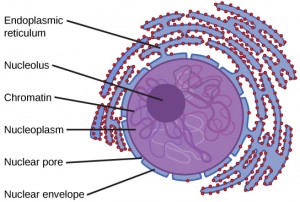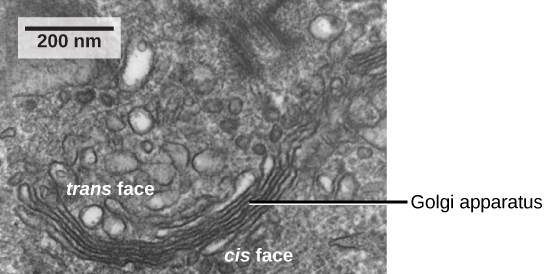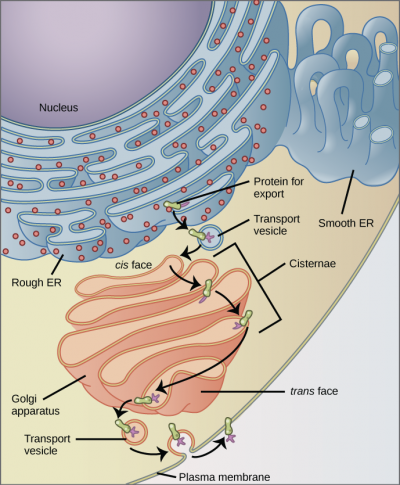1. Cell structure and Function
1.5.a. Cell organelles of both Plant and animals
Cell organelles of both plant and animal cell
Dr V Malathi and Mrs Sushumna Rao
The Nucleus
The nucleus (plural = nuclei) is the most prominent and largest organelle in a cell. It is the cell’s control center.
The DNA is present in the nucleus. The DNA is encoded with the genetic information.
Nucleus contains a thick liquid called nucleoplasm
The composition of nucleoplasm is similar to that of cytoplasm.
Most eukaryotic cells contain just a single nucleus.
Some types of cells like red blood cells contain no nucleus and a few other types of cells such as muscle cells contain multiple nuclei.
The nucleus is surrounded by a double membranous structure called the nuclear envelope.
The tiny holes are present in the nuclear envelope and these are called nuclear pores through which molecules move in and out of the nucleus.
The structure called nucleolus is housed inside the nucleus. It is mainly involved in the assembly of ribosomes.
The ribosomes after being produced in the nucleus are exported to the cytoplasm, where they are involved in the synthesis of proteins.

“Nucleus” by CNX OpenStax, is licensed under CC BY 4.0
Mitochondria
The mitochondrion ( plural mitochondria) are the “powerhouse of a cell” as they make energy required for a cell .
They use organic compounds such as glucose and through metabolic process called Glycolysis, Tri carboxylic acid cycle and Electron transport chain make ATP ( Adenosine Triphosphate molecules)
Mitochondria have a complex structure including an inner and outer membrane.
The inner membrane contains a version of cytoplasm, called matrix.
Can mitochondria be considered a cell? as they have there own DNA and ribosomes.
To explain this scientists have put forward a theory called Endosymbiotic theory.
According to this theory mitochondria were once considered to be free-living organism as they contain their own DNA and were considered as ancient prokaryotic cells.
These cells were then engulfed by larger prokaryotic cells.
The two cells then evolved a symbiotic relationship where the larger cells provided the smaller prokaryotes with a place to live. In return, the larger cells got extra energy from the smaller prokaryotes.
Eventually, the smaller prokaryotes became permanent guests of the larger cells and stayed as organelles inside them.
Endoplasmic Reticulum
The endoplasmic reticulum (ER) is a series of interconnected membranous tubules.
There are two separate areas of the endoplasmic reticulum: the rough endoplasmic reticulum and the smooth endoplasmic reticulum, respectively.
The hollow portion of the ER tubules is called the lumen or cisternal space.
The membrane of the ER is a phospholipid bilayer embedded with proteins and is continuous with the nuclear envelope.
The rough endoplasmic reticulum (RER) : This is so named because when viewed through the electron microscope ,the ribosomes attached to its cytoplasmic surface give it a studded appearance . The ribosomes synthesize proteins while attached to the ER and transfer of the newly synthesized proteins into the lumen of the RER . Here the proteins undergo modifications such as folding or addition of sugars. The RER also makes phospholipids for cell membranes
The phospholipids or modified proteins that are not destined to stay in the RER, will be packaged within vesicles and transported from the RER by vesicles budding from the membrane. Since the RER is abundant in cells that secrete proteins, such as the liver.

“Rough endoplasmic reticulum” by Laboratoires Servier, is licensed under CC BY 4.0
The smooth endoplasmic reticulum (SER) : This is continuous with the RER but has few or no ribosomes on its cytoplasmic surface.It serves the following functions such as :
- Synthesis of carbohydrates, lipids (including phospholipids), and steroid hormones;
- Detoxification of medications and poisons;
- Alcohol metabolism; and
- Storage of calcium ions.

“Smooth endoplasmic reticulum” by Laboratoires Servier, is licensed under CC BY 4.0
The Golgi Apparatus
These are the sorting organelles of the cell .
The golgi apparatus also known as the golgi bodies are a series of flattened membranous sacs.
Before reaching their final destination, the lipids or proteins within the transport vesicles need to be sorted, packaged, and tagged so that they are delivered to the required destination of the cell.
“Golgi apparatus” by Openstax is licensed under CC BY 4.0
The Golgi apparatus has a receiving face near the endoplasmic reticulum called the Cis golgi and a releasing face on the side away from the ER called the Trans golgi, toward the cell membrane.
The transport vesicles from the ER travel to the Cis face, fuse with it, and empty their contents into the lumen of the Golgi apparatus.
As the proteins and lipids travel through the Golgi, they undergo further modifications.
The most frequent modification is the addition of short chains of sugar molecules. The newly modified proteins and lipids are then tagged with small molecular groups to enable them to be routed to their proper destinations.
Finally, the modified and tagged proteins are packaged into vesicles that bud from the Trans face of the Golgi.
Some of these vesicles, transport vesicles, deposit their contents into other parts of the cell where they will be used,
While other secretory vesicles, fuse with the plasma membrane and release their contents outside the cell.
Salivary gland cells , immune cells that engage in a great deal of secretory activity such as secreting digestive enzymes or secretion of antibodies have an abundant number of Golgi.
In plant cells, the Golgi has an additional role of synthesizing polysaccharides, some of which are incorporated into the cell wall and some of which are used in other parts of the cell.
Ribosomes
Ribosomes are the cellular structures responsible for protein synthesis.
When viewed through an electron microscope, ribosomes appear either as clusters (polyribosomes) or single, tiny dots that float freely in the cytoplasm.
They may be attached to the cytoplasmic side of the plasma membrane or the cytoplasmic side of the endoplasmic reticulum and the outer membrane of the nuclear envelope
Ribosomes, which are large complexes of protein and RNA,
They consist of two subunits, called large and small subunit.
Ribosomes receive their “instructions” for protein synthesis from the nucleus,
The DNA in the nucleus is transcribed into messenger RNA (mRNA). This process is called Transcription.
The mRNA travels to the ribosomes, which translate the code provided by the sequence of the nitrogenous bases in the mRNA into a specific order of amino acids in a protein. This process is called translation.

“Ribosomes” by Openstax is licensed under CC BY 4.0
Peroxisomes
These are small, round organelles enclosed by single membranes.
Their chief function are :
- They carry out oxidation of fatty acids and amino acids.
- They also detoxify many poisons that may enter the body.
- Alcohol is detoxified by peroxisomes in liver cells.
A byproduct of these oxidation reactions is hydrogen peroxide, H2O2, which is contained within the peroxisomes to prevent the chemical from causing damage to cellular components outside of the organelle.
Hydrogen peroxide is then safely broken down by peroxisomal enzymes into water and oxygen.
“Peroxisomes” by Openstax is licensed under CC BY 4.0
Check your understanding about cell organelles
Glycolysis is a central metabolic pathway that is used by all cells for the oxidation of glucose to generate energy in the form of ATP (Adenosine triphosphate) and intermediates for use in other metabolic pathway.
TCA cycle or tricarboxylic acid cycle is also known as citric acid cycle or kreb's cycle and occurs in the matrix of mitochondria.The TCA cycle plays a central role in the breakdown, or catabolism, of organic fuel molecules.
The electron transport chain is a series of four protein complexes that couple redox reactions, creating an electrochemical gradient that leads to the creation of ATP in a complete system named oxidative phosphorylation. It occurs in mitochondria in both cellular respiration and photosynthesis
It is the process by which cells copy a particular portion of its DNA nucleotide sequence—a gene—into an RNA nucleotide sequence.
Translation is the process of conversion of nucleic acid information into amino acids.



